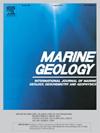Did Globigerinoides ruber (pink) disappear entirely from the Indian Ocean after 120 kyr BP?
IF 2.2
3区 地球科学
Q2 GEOSCIENCES, MULTIDISCIPLINARY
引用次数: 0
Abstract
Extant since the Miocene, Globigerinoides ruber is a mixed-layer planktic foraminiferal species, cosmopolitan to the tropical–subtropical oceans. Globigerinoides ruber has multiple morphotypical variants with distinctive white and pink chromotypes. Today, the pink variety is exclusively found in the Atlantic Ocean and its nearby basins. For the past few decades, it was believed that pink-pigmented G. ruber disappeared from the Indo-Pacific Oceans at about 120 kyr BP. However, a recent study from the northwestern Bay of Bengal documented the presence of G. ruber (pink) in surface sediments. Hitherto, there was no evidence of G. ruber (pink) in downcore sediments from the Indian Ocean since 120 kyr BP. In this study, for the first time, we document the re-appearance of G. ruber (pink) from 30 to 8 kyr BP in gravity core MGS30/GC-03. The core was retrieved from the eastern BoB from a water depth of 1883 m, and its chronology was established using eight AMS radiocarbon dates. We observed high abundances of G. ruber (pink) during the Last Glacial Maximum (LGM) and Heinrich Event 1 and 2 (H1 and H2) compared to the Holocene Epoch. Higher abundances of G. ruber (pink) during the LGM were followed by a gradual decrease during the deglaciation and the early Holocene until it disappeared after around 8 kyr BP. Variability in the relative abundance of G. ruber (pink) was compared with mixed-layer and thermocline-dwelling species. The high abundance of G. ruber (pink), N. dutertrei and G. menardii during H2 and LGM in the eastern BoB suggests enhanced NE monsoon-driven vertical mixing, which may have facilitated nutrient transport from deeper layers to the thermocline and photic zone. The presence of G. ruber (pink) during glacial stages and the early Holocene demonstrates that it has not entirely disappeared from the Indian Ocean since 120 kyr BP and that its turnover may be driven by changing hydrographic conditions.
Globigerinoides rubber(粉色)在距今120万年后从印度洋上完全消失了吗?
gloigerinoides ruber是一种存在于中新世以来的混合层浮游有孔虫,广泛分布于热带-亚热带海洋。gloigerinoides橡胶具有多种形态变异,具有独特的白色和粉红色染色体型。今天,粉红色的品种只存在于大西洋及其附近的盆地。在过去的几十年里,人们认为粉红色的G. ruber在大约120千年前从印度太平洋消失了。然而,最近一项来自孟加拉湾西北部的研究记录了G. ruber(粉红色)在地表沉积物中的存在。迄今为止,在距今120万年以来的印度洋下核沉积物中没有发现G. ruber(粉红色)的证据。在本研究中,我们首次在MGS30/GC-03重力岩心中记录了30 ~ 8 kyr BP的G. ruber(粉红色)的重新出现。岩心采集自东段水深1883 m,采用8个AMS放射性碳定年法确定了岩心年代学。在末次盛冰期(LGM)和海因里希事件1和2 (H1和H2)期间,与全新世相比,G. ruber(粉红色)的丰度较高。在LGM时期,G. ruber(粉红色)的丰度较高,随后在去冰期和全新世早期逐渐减少,直到约8kyr BP后消失。比较了混合层和温斜生境物种的相对丰度变异。在北半球东部的H2和LGM期间,G. ruber(粉红色)、N. dutrei和G. menardii丰度较高,表明东北季风驱动的垂直混合增强,这可能促进了营养物质从较深的层向温跃层和光带的运输。G. ruber(粉红色)在冰期和全新世早期的存在表明,自120kyr BP以来,G. ruber并没有完全从印度洋消失,其更替可能是由水文条件的变化驱动的。
本文章由计算机程序翻译,如有差异,请以英文原文为准。
求助全文
约1分钟内获得全文
求助全文
来源期刊

Marine Geology
地学-地球科学综合
CiteScore
6.10
自引率
6.90%
发文量
175
审稿时长
21.9 weeks
期刊介绍:
Marine Geology is the premier international journal on marine geological processes in the broadest sense. We seek papers that are comprehensive, interdisciplinary and synthetic that will be lasting contributions to the field. Although most papers are based on regional studies, they must demonstrate new findings of international significance. We accept papers on subjects as diverse as seafloor hydrothermal systems, beach dynamics, early diagenesis, microbiological studies in sediments, palaeoclimate studies and geophysical studies of the seabed. We encourage papers that address emerging new fields, for example the influence of anthropogenic processes on coastal/marine geology and coastal/marine geoarchaeology. We insist that the papers are concerned with the marine realm and that they deal with geology: with rocks, sediments, and physical and chemical processes affecting them. Papers should address scientific hypotheses: highly descriptive data compilations or papers that deal only with marine management and risk assessment should be submitted to other journals. Papers on laboratory or modelling studies must demonstrate direct relevance to marine processes or deposits. The primary criteria for acceptance of papers is that the science is of high quality, novel, significant, and of broad international interest.
 求助内容:
求助内容: 应助结果提醒方式:
应助结果提醒方式:


